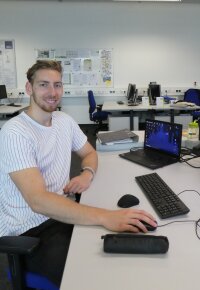
Masterarbeit (abgeschlossen)
Leander Wortmann
Bauingenieurwesen
Numerical simulations of frame structures with steel hollow section composite columns under seismic loads (beam-column connections)
Composite columns are particularly suitable for use in structures under seismic loads and have been frequently used in the past, for example, as Concrete Filled Steel Tubes (CFST). Frame constructions – Multi-Resistant-Frames (MRF), Braced Frames (CBF and EBF), and Dual frames – using steel-concrete composite columns are explicitly designed to limit lateral deflection and combine the advantages of steel and concrete, namely the rapid, manufacturing or construction, the strength and light weight of steel with mass, rigidity, damping, and economy of concrete.
Newly developed types of composite columns for high-rise buildings, such as concrete filled steel tube composite columns with additional embedded steel profile, are specifically designed for fire situations. They combine high and ultra-high strength steels with ultra-high-performance concrete, thus meeting the demanding requirements of modern multi-story buildings in terms of load-carrying capacities and dimensions.
The cavity between the hollow profiles is filled with concrete. Compared to reinforced concrete columns and comparable composite columns, they have smaller cross-sectional dimensions for the same load resistance, thus allowing the usable floor area to be increased. Slender, filigree columns are used in architectural steel construction and can also be realized with these profile types.
To predict the cyclic behavior of frame structures using these columns, the implementation of analytical models in finite element models is required. These have been optimized and elaborated in recent years for Concrete Filled Steel Tubes (CFST).
In this work, a numerical model is to be developed to simulate the cyclic behavior of frame structures using Concrete Filled Steel Tubes (CFST) and innovative composite columns with additional embedded steel profiles, such as Concrete Filled Double Steel Tube (CFDST) columns, made from normal and high-strength materials. The focus should be on the Investigation of the cyclic behavior of the composite columns by using static numerical models (Pushover) and cyclic test results. Additionally, the connection of beams to the hollow columns is to be analyzed.
Lehrstuhl und Betreuer
Lehrstuhl für Stahl-, Leicht- und Verbundbau(Univ.-Prof. Dr. Markus Knobloch)

Betreuung
M.Sc. Przemyslaw Schurgacz
